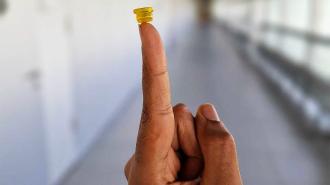A needle-free drug delivery system — inspired by peppercorns and octopus tentacles — could one day replace injections for administering drugs that can’t be taken orally. It sounds bizarre, but hear them out.
The challenge: Most drugs need to get into your bloodstream to work, and that can be a challenge for biopharmaceuticals, a class of drugs made from biological sources that includes synthetic insulin and GLP-1 agonists (the popular new weight-loss drugs).
“It’s an entirely new method of delivering medications that could spare millions of people the fear and pain associated with injections.”
Nevena Paunović
Because these drugs are relatively unstable and contain molecules that are large and heavy, it’s hard to take them orally — they degrade too much in the gastrointestinal tract and may be too large to enter the bloodstream through it. (Even when they can work, oral versions often require much higher doses because so little reaches the bloodstream, potentially increasing the cost.)
Instead, the drugs typically have to be administered via injections, which can be painful, inconvenient, and — if you belong to the 25% of the population that’s scared of needles — anxiety-inducing.
Needle-free drug delivery: Researchers at ETH Zurich have now developed a needle-free drug delivery method for biotherapeutics that looks like a tiny suction cup. Once filled with drugs, you stick it on the inside of your cheek like a patch to get the drugs into your bloodstream.
“It’s an entirely new method of delivering medications that could spare millions of people the fear and pain associated with injections,” said co-lead researcher Nevena Paunović.

How it works: Researcher Zhi Luo says he came up with the idea to deliver drugs this way when suction caused half of a peppercorn to get stuck to the inside of his cheek during a meal.
He and his colleagues set to work designing prototypes of a suction-based drug delivery system, drawing inspiration from the suckers on octopus tentacles, which are capable of sticking to wet, slippery surfaces. They then 3D-printed several designs and tested them on pig cheeks.
“We had to find out what geometry and how much of a vacuum were required to hold the suction cup in place on the mucosal lining of the cheek and to stretch it sufficiently without causing any damage,” said co-lead researcher Klein Cerrejon.

Next, the researchers looked for an inactive substance to use as an “excipient” — something that could serve as a carrier for a biotherapeutic inside their device and help it cross the stretched mucosal lining.
“Since the suction cup is a completely new delivery system, we had to experiment extensively before finding the right substance,” said Cerrejon. “It turned out that natural, endogenous substances are extremely well suited for this task.”
The results: After loading their needle-free drug delivery system with a mix of the carrier substance and desmopressin — a biopharmaceutical that helps regulate water in the body and that is known to have low oral absorption — the researchers tested it on dogs.
Compared to an oral form of the med, the suction cup device got up to twice as much of the drug into the animals’ bloodstreams.
The researchers then repeated the test with semaglutide, the weight-loss drug sold as Wegovy, and found that the device got about as much of the drug into the dogs’ bloodstreams as the FDA-approved oral form of the med (Rybelsus).
Because more than 90% of the drug remained in the device after 30 minutes, they think there’s an opportunity to increase absorption, perhaps by changing the rate at which the drug dissolves in the carrier or by simply leaving the suction cup in the mouth longer.

To test how people felt about the patch, the researchers asked 40 volunteers to attach ones filled with water to the insides of their cheeks for 30 minutes.
When asked how it felt to use the device, 37 participants said they felt nothing or only mild discomfort, and all 40 said they felt nothing unusual at the attachment site 24 hours after removing the suction cup.
Seven people said the device “moderately” affected their ability to speak, while 32 said the impact on speech was mild or non-existent (one volunteer didn’t answer the question). If they needed to take a drug daily, 31 said they’d opt for 30 minutes with the suction cup over an injection.

Looking ahead: The researchers note that they still need to study the impact of applying the suction cup repeatedly, like a person with diabetes would need to if they were using it to deliver insulin. The plan now is to conduct more tests in preparation for clinical trials on healthy volunteers.
Ultimately, Paunović and Cerrejon hope to found a startup, Transire Bio, to bring the needle-free drug delivery system to market as an alternative way to administer biopharmaceuticals.
“We have a prototype and have already patented the technology,” said Paunović. “Our next step is to manufacture the suction cup in a way that meets current pharmaceutical regulations.”
We’d love to hear from you! If you have a comment about this article or if you have a tip for a future Freethink story, please email us at [email protected].






